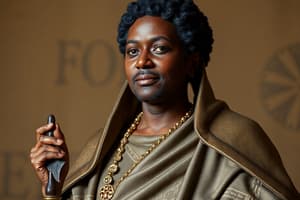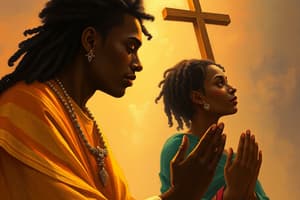Podcast
Questions and Answers
Where does all black history begin?
Where does all black history begin?
Africa
Who was the famous Alexandrian church father that provided commentary on the Song of Songs?
Who was the famous Alexandrian church father that provided commentary on the Song of Songs?
Origen
In Origen's interpretation, who does the bride in the Song of Songs represent?
In Origen's interpretation, who does the bride in the Song of Songs represent?
The Church
The queen of Sheba is believed to be of Ethiopian descent.
The queen of Sheba is believed to be of Ethiopian descent.
What does Origen suggest about the queen of Sheba's blackness?
What does Origen suggest about the queen of Sheba's blackness?
Which Old Testament figure did Origen mention as an example of blackness foreshadowing the Church?
Which Old Testament figure did Origen mention as an example of blackness foreshadowing the Church?
What modern city is located where the land of Kush was historically situated?
What modern city is located where the land of Kush was historically situated?
Who was the Nubian king that assumed power in Upper Egypt around the eighth century before Christ?
Who was the Nubian king that assumed power in Upper Egypt around the eighth century before Christ?
Which dynasty began with Piankhi in Egypt?
Which dynasty began with Piankhi in Egypt?
The ________ were known as the earliest beneficiaries of Egyptian civilization.
The ________ were known as the earliest beneficiaries of Egyptian civilization.
What did the Nubians build to demonstrate their cultural achievements?
What did the Nubians build to demonstrate their cultural achievements?
Flashcards are hidden until you start studying
Study Notes
African Roots in Black Catholicism
- Black history began in Africa and is a significant part of American black identity.
- Black Catholics looked to the African roots of the early church and its saints.
- Both Protestant and Catholic Americans found their roots in the black Ethiopians mentioned in the Bible.
- Origen, a third-century Church Father, interpreted the Song of Songs as a representation of the church.
- He believed the bride in the Song represented the church and that the Queen of Sheba was an Ethiopian with dark skin.
- The Septuagint translation of the Bible uses the phrase "I am black and beautiful."
- Origen saw the Queen of Sheba's blackness as symbolic of the church's universality and diverse people.
- He linked her to the church's origins in the "Gentiles," a term that referred to non-Jewish communities.
- Origen also pointed to the wife of Moses and Ebed-Melech, a Kushite, as examples of blackness in the Old Testament.
The Kushite Kingdom and its Impact
- The land of Kush in the Old Testament was often synonymous with Nubia, a region south of Egypt.
- Nubians were historically connected to Egypt, serving as mediators between Egypt and sub-Saharan Africa.
- Nubia, while influenced by Egypt, established its own unique culture, architecture, and writing system.
- By the 8th century BCE, Nubia became a dominant power, even ruling over Egypt for a century with black pharaohs.
- The XXVth dynasty, led by Nubian pharaohs like Piankhi, is well-documented in history and the Old Testament.
- Isaiah refers to powerful Nubian warriors in his prophecies, highlighting their military strength and influence.
- The prophets emphasized the historical presence of Nubians as a significant force in the ancient world.
Studying That Suits You
Use AI to generate personalized quizzes and flashcards to suit your learning preferences.



